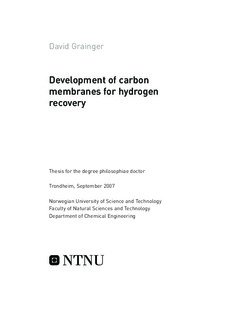| dc.description.abstract | The recovery of hydrogen from gas mixtures with hydrocarbons may provide a commercial niche for carbon molecular sieve membranes (CMSMs). Previous work has shown that carbon membranes achieve excellent performance, with respect to hydrogen permeability and selectivity, in the separation of hydrogen from light hydrocarbons, such as CH4, and CO2. The intent of this work was to screen CMSMs derived from cellulose-hemicellulose for H2 recovery and to generate performance data so that commercial application could be simulated. Three fields of application were evaluated: 1) the separation of hydrogen from a mixed H2-natural gas network in a hydrogen-based society concept, 2) recovery from refinery waste gases and 3) capture of CO2 in a precombustion coal-fired power plant. The key separation components were therefore H2, CH4 and/or CO2, with nitrogen and C2-C4 hydrocarbons sometimes present as smaller fractions.
The precursor material was an 80% cellulose-20% hemicellulose mixture derived from spruce and pine pulp. The final carbonization temperature was varied between 375°C and 700°C and a separation performance maximum found at about 650°C. Membranes carbonized at the low end had not yet developed sufficient porosity, whereas those carbonized at 700°C had experienced extensive pore closure. Copper (II) nitrate and silver nitrate were also added to the precursor in the range of 0-6 wt%. Copper (II) nitrate decomposed to copper oxide during pyrolysis and silver nitrate to silver, the latter often forming a layer on the membrane surface. SEM analysis showed dispersed clusters of the additive in the carbon film. Increasing the additive loading tended to decrease the permeability of H2, CO2 and CH4 but increased the selectivity of the H2/CH4 separation. H2/CO2 selectivity was best with about 4% copper nitrate loading. There was no significant advantage in doping the membrane with the more expensive silver nitrate compared with the copper nitrate.
The carbonization environment strongly affected separation properties. Deep vacuum (0.02-0.05 mbar) produced tight membranes with low hydrogen permeability and the highest H2/CO2 selectivity (>20 at 25°C). These membranes performed better than the productivity-selectivity trade-off for polymeric membranes. A higher carbonization pressure (0.34-0.41 mbar), which implies a higher oxygen partial pressure and more oxidation, led to more open, productive membranes that are better suited to H2/CH4 separation. All membranes prepared in this work exceeded the performance of polymers for this pair, with single gas H2 permeabilities at 25°C of up to ~1400 Barrer and selectivities of 1200 observed for new membranes. Carbon membranes were also prepared under an argon gas flow (a more practical method for mass production) and found to have similar performance to those prepared at the higher pressure under vacuum. After carbonization temperature, the most important factor determining performance was the length of exposure of the material to air. Aging due to chemi- and physisorption decreased membrane productivity by as much as 80% over 14 months, although the deterioration slowed over this time.
The effect of operating conditions was also studied. Increasing the operating temperature produced an exponential increase in productivity for all gases, but decreased the hydrogen selectivity. Feed pressure had little effect on separation below 6 bar, which was the equipment limit. The permeability of hydrogen was hindered by competitive adsorption by heavier gases, but short term testing showed the productivity to be reasonable and stable, even in the presence of propane and butane.
The operating data for the simulation of applications was taken from the performance of a carbon membrane prepared by doping the cellulose-hemicellulose precursor with 4wt% copper (II) nitrate and carbonizing it at 650°C. This data was for the ‘aged’ membrane, which still achieved excellent performance in mixed gas tests – approximately 500 Barrer and H2/CH4 and H2/CO2 selectivities of 1000 and 19, respectively, at 25°C.
The cost and energy consumption of H2 recovery from hydrocarbon streams varied considerably with the hydrogen partial pressure in the feed, degree of recovery and assumed membrane module cost ($50-500/m2). Ninety percent of the hydrogen could be recovered with >95 mol% purity from a stream containing as little as 5 mol% H2, in a single stage. Compared with a commercial polyimide membrane, the carbon molecular sieve produced purer hydrogen from leaner streams with lower energy consumption. The operating cost, which included a 15% capital charge, was similar to or lower than that of the polyimide membrane.
The separation of hydrogen from carbon dioxide and nitrogen, the main components in an IGCC precombustion stream, was simulated and compared with the performance of a CO2-selective facilitated-transport membrane. The CO2 compression duty in the CMSM process is higher because the nitrogen that is retained with the CO2 must be compressed too. The CO2 pipeline size increases because more gas must be transported. The second challenge is that the hydrogen must be recompressed as well, to turbine pressure. This is a particular issue because the H2/CO2 permselectivity ratio at the operating temperature of 90°C is only about 13 and so the permeate pressure was less than 3 bar to achieve good separation. | nb_NO |
